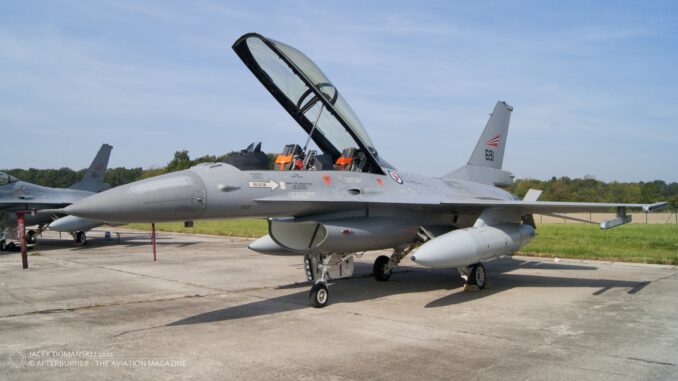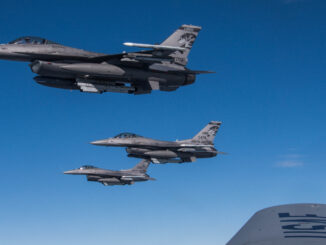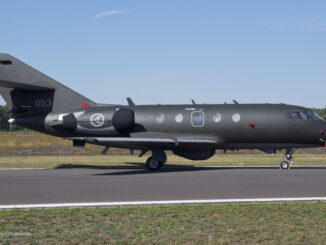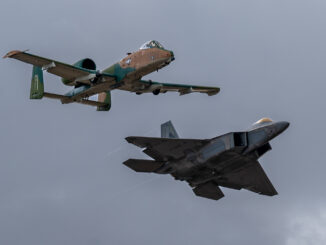
General Dynamics F-16BM Fighting Falcon, the Royal Norwegian Air Force ´691´, static display at NATO Days 2011, Ostrava-Mošnov, September 2011.
In the early 1970s, a few European NATO countries – Belgium, Denmark, the Netherlands and Norway – were trying to find a replacement for their F-104 Starfighter fleet. Because this coincided with the final stage of the Lightweight Fighter (LWF) development programme of the United States Air Force, the four abovementioned countries agreed on considering the acquirement of the LWF programme winner, under the condition it would be also ordered by the USAF.
The LWF programme then evaluated into the Air Combat Fighter competition, for a new, multi-role fighter for the USAF. On 13th January 1975 it was announced that YF-16 became a winner of the competition and a few months later, during the Paris Air Show organized in June, the four European countries – now commonly known as the European Participation Group – signed an agreement for participating in the development and production of the new fighter, together with pre-order for almost 350 aircraft.
The future fleet of European F-16 Fighting Falcon fighters started to be recognized as the European Participation Air Forces. New multirole aircraft for those four NATO countries had to be produced in Belgium (at SABCA plant) and the Netherlands (at Fokker Schiphol-Oost factory). Two further aviation companies from Norway (Kongsberg) and Denmark (Terma A/S) were also participating in the programme as parts manufacturers. The European co-production of F-16 was officially inaugurated in 1977.
The first ´Viper´ – as the aircraft is commonly called by crews and aviation geeks – for Luftforsvaret (the Royal Norwegian Air Force) was delivered in 1980. Norway ordered 72 aircraft in A and B variants and, unlike other countries from the European Participating Group, did not placed any follow-up orders.
Initially, the F-16 delivered to Norway were of Block 1 and Block 5 version but starting 1981 the aircraft were received in Block 10 and, since 1982, Block 15. In order to unify the fleet, all Block 1 and 5 ´Vipers´ were then upgraded to Block 10 variant. Starting from 2002, all operational F-16 in Norway (57 aircraft at that time) underwent the Mid-Life Update by implementing M3 MLU kits.
Currently, the Royal Norwegian Air Force still have over 50 operational F-16 aircraft, of which approximately 30 are in active use by 331 Squadron (331 skvadron, Bodø air base). However, Norway is now reducing its F-16 fleet as the new fighter – Lockheed Martin F-35 Lightning II, is now entering into service and replacing the ´Vipers´.
Luftforsvaret already received almost 30 Lightning II fighters, of which 7 are located in the USA and used for training purposes. The 332 Squadron is already equipped with F-35 and became operational, the 331 Squadron would be the next one. In 2020, the Norwegian F-35s for the first time were sent to Iceland and completed the Iceland Air Policing mission. It is expected, that in 2022, the Lightning II fighters would take over the QRA duties and then achieve Full Operational Capability status in 2025.
This also means the gradual reduction of operational flights performed by F-16s, from the annual average of 7,000 flying hours in 2010s, to 2,000 – 3,000 flying hours per year in 2020s and the final retiring of Norwegian ´Vipers´ in 2025. Due to the age and the amount of clocked flying hours, selling F-16s for another operator is not very likely so they would be scrapped.
And returning to our featured photo – it shows the F-16BM ´691´, exhibited at the static display during one of early NATO Days events in the Czech Republic, organized in September 2011. This aircraft is rather well known for aviation enthusiasts, as in 2019 it was re-painted to celebrate the 75th anniversary of the Royal Norwegian Air Force and the D-Day anniversary. At this opportunity, the F-16 was painted in the livery of Spitfire IX ´FN-K´ of the No. 331 (Norwegian) Squadron of the Royal Air Force, that participated in the D-Day operation.
However, this time we have decided to show this aircraft in its original livery and share the photo taken ten years ago. In addition, we will also share some pictures of ´691´ in Spitfire livery soon, in one of our special reports.



